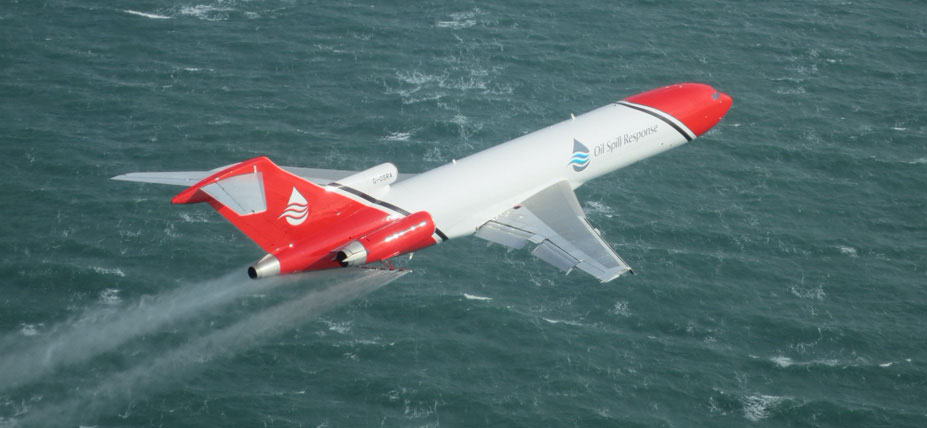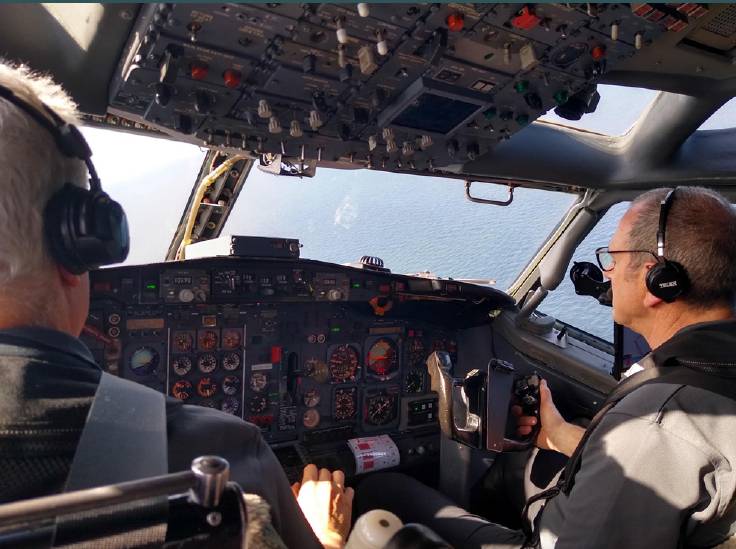AEROSPACE Special mission conversions
Thrills and spills
In May AEROSPACE was invited to go on a low-level training flight in one of the two OSRL special mission oil dispersant Boeing 727s at 150ft over the Irish Sea.

The OSRL 727s are flown on weekly training exercises in which they make low-level passes dropping water over a restricted area of sea. On 26 May, AEROSPACE was invited to be in the cockpit during one of these exercises. The flight was on the backup 727 G-OSRB, flying west from Doncaster over BAe Warton to a specially restricted area of the Irish Sea west of Blackpool.
Piloted by Cp Dan Griffith and Cp Pat Cafferky we took off from Doncaster and headed west at 8,000ft as far as Warton where the aircraft performed a low-level go-around over Warton airfield and then over the Irish Sea. We had been given our own special Notices to Airmen (NOTAM) announcing that we would be conducting ‘dynamic low-level manoeuvring over sea’ in a restricted area west of Blackpool.
We descended to 1,000ft and lined up for our approach for the first spray run. Flight Engineer Ted Morris calls out our height as we go down.
“500 – check – 400 – check – 300 - check”
The sea below is rapidly becoming closer.
“200 – 190 - 180 - 170 – 160 – 150”
We level off at 150 feet above the sea.
“150 – 140 – 150”
The Flight Engineer continues to call out our height reading from a radar altimeter a system which was retro-fitted to the 727 to ensure safe separation from the sea during the spray runs. The pilot adjusts our height to keep the aircraft level. The view of the waves out of the cockpit window is not dissimilar to that which might be seen from a fast ship such as a hydrofoil, except that we are in an airliner. This is not an ordinary flight – this is more like training for the Dambusters’ raid.
 AEROSPACE/Bill Read“150 - Spray on - 140 - right one degree”
AEROSPACE/Bill Read“150 - Spray on - 140 - right one degree”
Ted Morris presses the controls on the flight engineer’s panel to begin the spray test. Because this is a training mission, we are spraying water rather than chemical dispersant. There is no change in noise from within the cockpit but outside the aircraft the spray booms are now pumping a constant flow of water out over the sea.
“150 – 140 – 150 – that’s the end of the spill – spray off – climbing up”
We ascend again up to 1,000 feet and manoeuvre round to begin another low-level pass.
We start to descend to begin our second run. We are now flying at 150ft at a speed of 150kt (well below the 480kt or Mach 0.84 that the 727 is capable of) and only 45kt above the stalling speed at flap 15. ‘Spray on,’ orders the Captain. “Spray on,” repeats the Flight Engineer who then pressures the switches on his control station. Somewhat disappointingly, there is no loud hissing noise but the cockpit is already noisy from the sound of the engines and the TERSUS pumps and spray booms are at the rear of the aircraft. As the spray leaves the aircraft, the Flight Engineer continues to call out our height, which varies from 140 to 160ft above the sea. “That’s the end of the spill,” says the Captain. “Spray off.” Spray off,” repeats Ted Morris. “Climbing up,” says the Captain and we ascend back up to 1,000ft which seems very high after being so close to the sea.
We bank over the sea to begin our third and final run. The weather is good today but I am told that the aircraft can operate in up to 34kt crosswinds. High winds are apparently a good thing in some cases, as they act as an additional dispersant for oil spills. However, oil dispersal flights are always carried out during daylight hours as the crew need to be able to see the spill and do not have night vision goggles to operate at night.
The tests are complete and we ascend again and turn back towards the coast. Soon afterwards we land again at Doncaster with another training mission completed.